Paolo Bombelli (Postdoctoral Researcher)
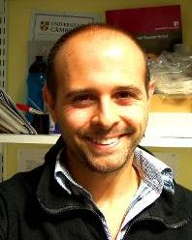
Email: pb346@cam.ac.uk
My research interests
My interest in phobiology and electrochemistry began during my undergraduate studies at the University of Milan. My long term goals concentrate on exploring the potential of these hybrid systems in which photobiological elements (e.g. cyanobacteria and microalgae) are used in electrochemical set-ups (e.g., microbial fuel cell like) for the direct generation of electrical current, driving electro-synthesis and as bio-environmental sensors.
These concepts are developed under the name of PBES (photo-bio-electrochemical-system) or BPV (bio-photovoltaic – when only oxygenic photosynthetic organisms are used).
Bio Photo Voltaic (BPV) & plant Bio Electrochemical Systems (plant-BES)
The BPV systems operate using photosynthetic oxygenic micro-organisms (prokaryotic and eukaryotic) associated with an electrode, growing either as a biofilm on the electrode or as cells in suspension. I have shown that photosynthetic cells grown as biofilms can supply electrons directly to the electrode without the need for exogenous chemical mediators. Although the power output is low at present (ca. 100 mW m-2), I have recently managed to achieve over 5-fold increases in power output using micro-scale devices. Researching ways to further increase this power output forms a core part of my ongoing work. The schematic below displays the main components for a generic BPV system.
In an alternative to oxygenic photosynthetic micro-organisms, I am also investigating bryophyte and vascular plant systems. In this configuration, the photosynthetic plant is used for feeding heterotrophic bacteria in the rhizosphere. Then those bacteria produce current that can be collected by an anode. The schematic below displays the main components for a generic plant-BES system.
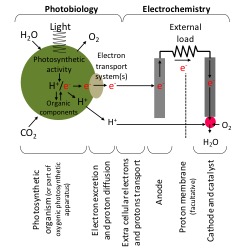
Schematic cartoon for a BPV system.
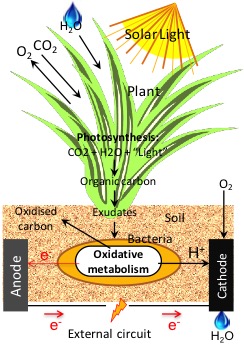
Schematic cartoon for a plant-BES system.
Ongoing projects
1. Biological electron transport in BPV systems
Any PBES and BPV system vitally relies on several steps of electron transport. These include 1.1) photosynthetic and respiratory electron transport1, 1.2) the pathway that electrons take through the intracellular (cytoplasmic) space2 and 1.3) the mechanisms involved in cellular electron export from leaving the cells to reach the anodic surface3.
There is a two-way rationale that links the study of the electron transport and the development of BPV systems. Understanding the process of electron transport in photosynthetic organises is an essential step for developing more effective bio electrochemical systems. But also the systems can also be used for investigating electron transport in autotrophic and heterotrophic organisms.
[1] Bombelli 2011 Energy Environ. Sci., doi: 10.1039/C1EE02531G.
[2] Bradley 2013 Phys. Chem. Chem. Phys., doi: 10.1039/c3cp52438h.
[3] Anderson 2015 Plant Biotechnology Journal, doi: 10.1111/pbi.12332.
2. µ-channel BPV
We have demonstrated that soft lithography can be successfully used to create µ-BPV systems. These BPV devices were operated with few µL(s) of suspension of Syenchocystis 6803. The total number of cells were expected to be in the order of a few hundred thousand and these BPV systems were giving us the highest power densities yet reported for BPVs (~100 mW m-2)4.
With this ongoing project we are constructing BPV systems in even smaller volume (i.e., ultra-small volume) to verify the hypotheses that microfuidic devices can be used to measure output from small numbers of cells (ideally a single cell).
[4] Bombelli 2014 Advanced Energy Materials, doi: 10.1002/aenm.201401299.
3. Electrogenic activity of plants (vascular plant and moss)
This investigation has begun in 2012 when Oryza sativa and Echinochloa glabrescens were used to generate power in a PBES system. O. Sativa was chosen as a common crop and E. glabrescens as an invasive species. The study successfully proved the generation of power from both plants5. This investigation has triggered a further plant-BES study that has been conducted with the model moss species Physcomitrella patens.
These studies have triggered a collaboration with Cape Town University (South Africa) where the accumulation of rhizodeposits (e.g., sugars, organic acids) in the plant soil and the effect of these compounds on the growth of microbial rhizospheric communities are analysed.
[5] Bombelli 2013 Appl Microbiol Biotechnol., doi: 10.1007/s00253-012-4473-6.
4. Electrosynthesis of hydrogen
Solar powered hydrogen generation is a sustainable means of generating a clean fuel that could alleviate impending energy problems. A myriad of approaches have been investigated to achieve this goal, one of which involves the use a BPV system equipped with algal cells as a means of using sunlight to convert water into oxygen and hydrogen gas6.
In order to build low-cost BPV algae systems, which can ultimately be scalable, the platinum cathode must be replaced with a more earth abundant alternative that can catalyse the hydrogen evolution reaction at a low over-potential (e.g., Cobaloximes and the [NiFeSe]-hydrogenase).
[6] McCormick 2014 Energ Environ Sci., doi:10.1039/C3EE40491A.
5. Moss at the Zoo (M@Z)
M@Z is a Moss-BES system being developed since last June (2014) in collaboration with Alasdair Davies and Louise Hartley (London Zoological Society), Ross Dennis (Cambridge/ANU), and Fabienne Felder (Switzerland), to create an engaging and interactive public display at the London Zoo that demonstrates the capability of moss-BES systems to a large audience. The M@Z comprises 12 moss-BPV units and a Wild camera trap system as shown in the figure below (figure 4).
This installation is aiming to test the ability of Moss-BES to power (partially or completely) an “Wild camera trap” and showcase the PBES-BPV technology and the work of the ZSL’s Conservation Unit.
Publication (last 5 years)
2015 McCormick AJ, Bombelli P, Bradley RW, Thorne R, Wenzel T and Howe CJ (2015) Biophotovoltaics: oxygenic photosynthetic organisms in the world of bioelectrochemical systems. Energy Environ. Sci., 2015, doi: 10.1039/C4EE03875D
2015 Anderson A, Laohavisit A, Blaby I, Bombelli P, Howe C, Merchant S, Smith A, Davies, Julia (2015). Exploiting algal NADPH oxidase for biophotovoltaic energy. Plant Biotechnology Journal, doi: 10.1111/pbi.12332.
2014 Bombelli P, Mueller T, Herling TW, Howe CJ, Knowles TPJ (2014) A high power-density mediator-free microfluidic biophotovoltaic device for cyanobacterial cells. Advanced Energy Materials, DOI: 10.1002/aenm.201401299
2014 Lea-Smith DJ, Bombelli P, Dennis JS, Scott SA, Smith AG, Howe CJ (2014) Phycobilisome-deficient strains of Synechocystis sp. PCC 6803 have reduced size and require carbon-limiting conditions to exhibit enhanced productivity. Plant Phys., 165:705-714
2013 Bradley RW, Bombelli P, Lea-Smith DJ, Howe CJ (2013) Terminal oxidase mutants of the cyanobacterium Synechocystis sp. PCC6803 show increased electrogenic activity in biological photo-voltaic systems. Phys. Chem. Chem. Phys., 15:13611-13618
2013 McCormick AJ, Bombelli P, Lea-Smith DJ, Bradley RW, Scott AM, Smith AG, Fisher AC and Howe CJ (2013) Hydrogen production through oxygenic photosynthesis using the cyanobacterium Synechocystis sp. PCC 6803 in a bio-photoelectrolysis cell (BPE) system. Energ Environ Sci., 6:2682-2690
2012 BombelliP, Iyer DMR, Covshoff S, McCormick AJ, Yunus K, Hibberd JM, Fisher AC and Howe CJ (2012) Comparison of power output by rice (Oryza sativa) and an associated weed (Echinochloa glabrescens) in vascular plant bio-photovoltaic (VP-BPV) systems. Applied Microbiology and Biotechnology, 97:429-438
2012 Bradley RW, BombelliP, Rowden SJL and Howe CJ (2012) Biological Photovoltaics: Intra- and Extra-cellular Electron Transport by Cyanobacteria. Biochem Soc Trans., 40: 1302-1307
2012 Bombelli P, Zarrouati M, Thorne RJ, Schneider K, Rowden SJL, Ali A, Yunus K, Cameron PJ, Fisher AC, Wilson DI, Howe CJ, McCormick AJ (2012) Surface morphology and surface energy of anode materials influence power outputs in a multi-channel mediatorless bio-photovoltaic (BPV) system. Phys Chem Chem Phys., DOI:10.1039/C2CP42526B
2011 Thorne RJ, Hu H, Schneider K, Bombelli P, Fisher AC, Peter LM, Dent A and Cameron PJ (2011). Porous ceramic anode materials for photo-microbial fuel cells J. Mater. Chem., 2011, 21, 18055-18060
2011 McCormick AJ, Bombelli P, Scott AM, Philips AJ, Smith AG, Fisher AC, Howe CJ (2011) Photosynthetic biofilms in pure culture harness solar energy in a mediatorless bio-photovoltaic (BPV) cell system. Energ Environ Sci., 4:4699-4709
2011 Bombelli P, Bradley RW, Scott AM, Philips AJ, McCormick AJ, Cruz SM,Anderson A, Yunus K, Bendall DS, Cameron P, Davies J, Smith AG, Howe CJ, Fisher AC (2011) Quantitative analysis of the factors limiting solar power transduction by Synechocystis sp. PCC 6803 in biological photovoltaic devices. Energ Environ Sci., 4:4690-4698
Translational projects
I have also established collaborations with designers in order to embed the PBES and BPV technology into everyday items, resulting in, for example, the ‘Moss Table’ and ‘Moss FM’ and the ‘Plant to Power’ (P2P).
The Moss Table
The Moss-Table is a conceptual design intended to demonstrate the potential of bio photo voltaic technology. I have created the moss table in collaboration with two designers, Carlos Peralta, Alex Driver and James Moultrie (Institute for Manufacturing). The Moss-Table has been exhibited in several events at the London Design Festival (2011), the Milan Furniture Fair (2012), the Envie Alive Paris (2013), and the Living Matter Rotterdam (2014). However, it has also been featured in a British Council video to showcase UK technology in the Far East. In addition, the Moss-Table has received the winning prizes such as “The People's Choice” Icon award (Anglia Ruskin 2012), and the “Lápiz de Acero” award, Colombia, South America, 2012.
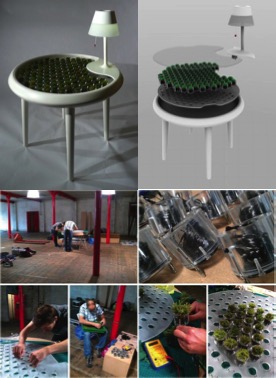
Links for the Moss table:
http://biophotovoltaics.wordpress.com/moss-table/
https://en-gb.facebook.com/MossTable
http://www.youtube.com/watch?v=Tw7JcOHNZlY
The MossFM
Moss-FM is the World’s first plant-powered radio (see picture aside). This has been created by Fabienne Felder, a creative strategist and designer originally from Switzerland. The Moss-FM received extensive international press coverage (including The Independent, March 9, 2014) and global attention via blogs and newsletters. Recently, it has been exhibited at the Orgatec Fair in Cologne (October 2014) and at the SAPS big teachers' conference at the University of Reading (January 2015).
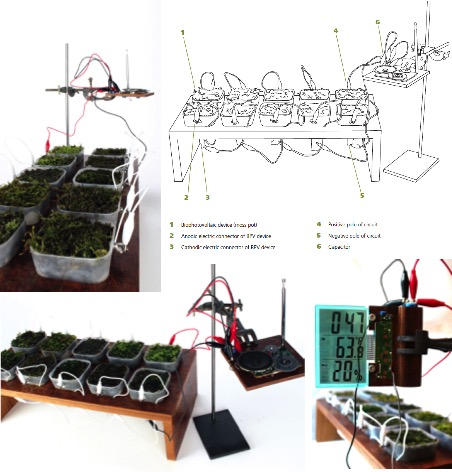
Links for the MossFM:
https://www.youtube.com/watch?v=YV8nKPdu_Xs
https://www.behance.net/gallery/Moss-Radio/10671027
Plant to Power (P2P)
The P2P (Plant to Power) is a prototype of ‘solar hub’ built to test the potential of different combinations of green technologies to generate power. I have developed the P2P by leading a team of scientists in collaboration with a local designer (Margherita Cesca) and two commercial partners (Polysolar, Scotscape). The P2P solar hub combines two types of solar technologies: traditional solar panels (PV) and biological solar panels (plant-BES). The P2P solar hub is housed at the Botanical Garden in Cambridge (UK). The installation has been officially opened in March 2015. In the long-term the P2P is a prototyping a range of self-powered sustainable buildings for diverse use all over the world from bus stops to refugee shelters
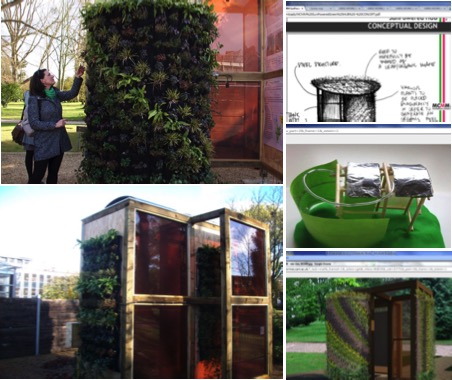
Links for the P2P:
https://www.plantsci.cam.ac.uk/p2p
http://131.111.37.52/index.php
Collaborators
Dr. Robert Bradley
http://www.imperial.ac.uk/people/r.bradley
Dr. Julia Davies
http://www.plantsci.cam.ac.uk/directory/davies-julia
Mr. Alex Driver
https://uk.linkedin.com/pub/alex-driver/13/850/912
Ms. Fabenne Felder
http://www.behance.net/FabienneFelder
Professor Sue Harrison
http://www.chemeng.uct.ac.za/staff/academic/harrison/
Prof. Tuomas Knowles
http://www-knowles.ch.cam.ac.uk/
Dr. Alistair McCormick
http://www.ed.ac.uk/schools-departments/biology/people?id=amccormi&cw_xml=research_profile.php
Dr James Moultrie
http://www.ifm.eng.cam.ac.uk/people/jm329/
Prof. Peter Nixon
http://www.imperial.ac.uk/people/p.nixon
Dr. Brenda Parker
https://iris.ucl.ac.uk/iris/browse/profile?upi=BMPAR74
Dr. Carlos Peralta
http://arts.brighton.ac.uk/staff/carlos-peralta
Dr. Erwin Reisner
http://www-reisner.ch.cam.ac.uk/group.html
Dr. Stefano Santabarbara
http://www.researchgate.net/profile/Stefano_Santabarbara/
Dr Beatrix Schlarb-Ridley
http://www.energy.cam.ac.uk/directory/bgs21@cam.ac.uk
Professor Alison Smith
http://www.energy.cam.ac.uk/directory/as25@cam.ac.uk
Professor Ulli Steiner
http://www.phy.cam.ac.uk/people/steineru.php
Dr. Felice Torrisi
http://www.graphene.cam.ac.uk/people/ft242@eng.cam.ac.uk
Sponsor
Partners
Metrics
Google Scholar
Scopus
http://www.scopus.com/authid/detail.url?authorId=6506720779
ResearchGate
http://www.researchgate.net/profile/Paolo_Bombelli








